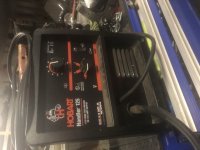I'm gonna suggest you're going to be disappointed with a 110v welder. They not very easy to use even if you know how to weld. Just not enough power.
And cheapo welders have cheapo components, (gas guages guns and wire feed) that distracts from you trying learn.
And if you're going to teach yourself how to weld you are MUCH better off with a multi process TIG. Go watch AVE or thisoldtony youtube clips, they explain it well.
If you're gonna teach yourself how to weld start watching "how to" videos on youtube. There's lots of them sponsored by the welding equipment manufacturers. The Lincoln guy is good.
There are LOTS of used welders on Kijiji. Most of them are new or almost new 110v MIG setups... but a quick check I saw 141A multi function inverter TIG with torch, guages, the whole setup for $700
Visit Kijiji Classifieds to buy, sell, or trade almost anything! New and used items, cars, real estate, jobs, services, vacation rentals and more virtually anywhere.

www.kijiji.ca
And buy the bottle. If you rent, you can only get it filled where you rent it; which quickly turns into a problem
If you check the electric code, wiring for a welder is a special instance.
A 50amp outlet, by code, has to put out 50A continuously without over heating. Because welders have a low duty cycle, typically less than 20%, the wire can be smaller guage.
You can basically define the quality of the machine by it's duty cycle. Cheapos can be as low as 7%.
If your house was built in the last 50 years it has 100A service. If you have electric heat you might have 150A service.
My house was wired for a X-ray machine. I have 200A service.
To upgrade to 200A service you have to replace the feed from your panel to the pole. You'll need a new panel and cut-off. COSTS = $$$$$$$
They're probably going to start wiring residential for 200A when electric cars become more popular.
If you plan on spending lots of time in the garage it is a good idea to pull a pony board in the garage. That way you run ONE big circuit (wire is expensive) back to the big panel and when you pop a breaker in the garage you don't have to walk all the way to the basement to reset it.
I went backwards.
At the shop I used to have a REALLY OLD 600V 3 phase TIG. The only adjustments on the machine: amperage or off. ... but it would put out HUGE amperage, it was like holding a lightning hose.
When I moved up here I bought a new fangled fancy-dancy Esab inverter. You can adjust voltage, amperage, pulse width, frequency, ramp up, ramp down, pre and post gas and a bunch of other stuff.
I can't make the stupid thing work. I set it at max amps and 60Hz, 50/50, the setup you would get from a non-fancy-dancy inverter and go to it. Works for me.
I recommend the fancy-dancy inverters.



















